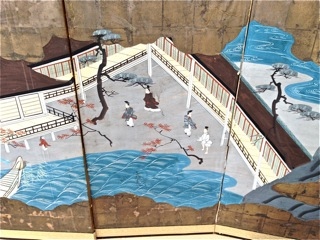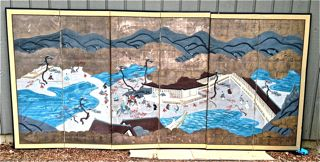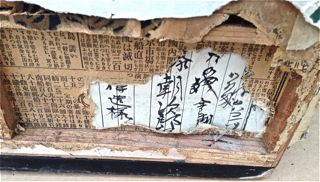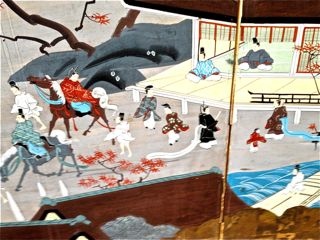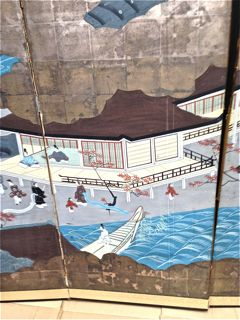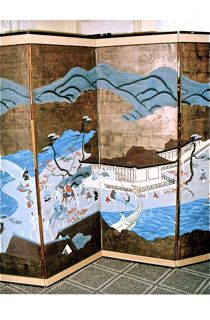
|
Subject:Re: Edo Period Large Japanese Screen
Posted By: sue Wed, Nov 25, 2015
Hi Margie
My expertise on byobu is a bit rusty, but this looks to be a late Edo period byobu of OK quality. I cannot enlarge the photos but it seems to be depicting a typical 'floating world, Genji type ' scene.
Byobu are traditionally mounted on wooden cores with a system of paper layers that are put on in succession to incorporate pockets of air. These layers and pockets help to protect the screen from damage from impact (to some extent ). The traditional material to use for this is recycled daifuku cho. Which are old account books. These account books are made of Kozo (mulberry ) paper and give a good quality ,non acidic base for the screen mounter to underlay the images on.
Typically a screen (and also scrolls )will be remounted occasionally. Your screen looks to have newsprint underneath instead of recycled account books. This is not very good for the artwork because newsprint is acidic and will slowly degrade the artwork. In my experience this technique of using old newspapers under sceens was started in the post war years (WW2) and was probably just a money saving technique.Not all post war screens are remounted like this though, many were still mounted in the correct , traditional manner. You can tell it is newsprint because it is printed, an old account book would have hand written pages visible. Remounting is an expensive, skilled and time consuming job. You screen should not be 'fixed' by restorers inexperienced in Japanese art. Hope this is of some help . Sue


|
 Edo Period Large Japanese Screen
Edo Period Large Japanese Screen  ( China & Japan ) - Margie - Nov 24, 2015 (10:21 PM)
( China & Japan ) - Margie - Nov 24, 2015 (10:21 PM)  Re: Edo Period Large Japanese Screen
Re: Edo Period Large Japanese Screen  - Margie - Nov 24, 2015 (11:10 PM)
- Margie - Nov 24, 2015 (11:10 PM)  Re: Edo Period Large Japanese Screen - sue - Nov 25, 2015 (01:36 AM)
Re: Edo Period Large Japanese Screen - sue - Nov 25, 2015 (01:36 AM)  Re: Edo Period Large Japanese Screen - Margie - Nov 26, 2015 (02:58 PM)
Re: Edo Period Large Japanese Screen - Margie - Nov 26, 2015 (02:58 PM) 